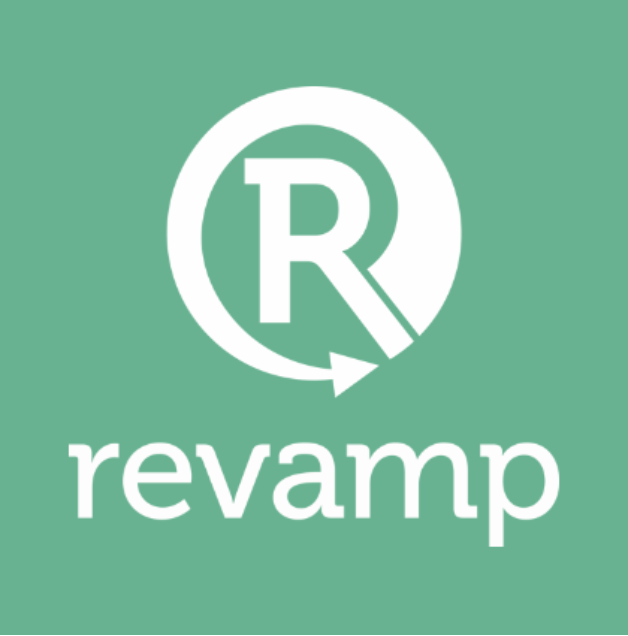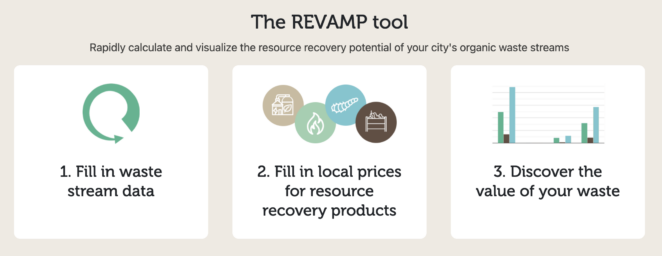Resource Value Mapping (REVAMP) Tool

This tool is part of theSEIUrban Toolbox for Liveable Citieswhichhas been developed by theSEI Initiative on City Health and Wellbeing.The Urban Toolbox isa collection of tools, developed within SEI or in coordination with SEI,aimed at supporting planning and decision-making for improving the health, well-being and resilience of city residents and urban systems more broadly.
GO TO THE SEI URBAN TOOLBOX FOR LIVEABLE CITIES HOMEPAGE
About this tool
Resource Value Mapping (REVAMP) is a decision support tool for rapidly estimating the resource recovery potential from organic waste streams: sewage sludge, faecal sludge and other organic solid waste. REVAMP calculates the potential amount of recovered product, its energy and nutrients contents and the potential revenue that could be obtained when sold for different scenarios. Ithelps city planners estimate the total resources and reuse potential available in a city’s wastewater and other organic waste streams, as well as their financial values. This could aid theplanning of new sanitation infrastructure, wastewater treatment plants, or climate mitigation measures.

How does this tool work?
Based on data input about the volume of the different waste streams, REVAMP calculates the benefits from different reuse scenarios – for example composting of faecal sludge for agricultural fertilizer, production of biogas or solid waste briquettes – in terms of energy and nutrient content, and how that compares to the content in other products that can be substituted by resource recovery products. Potential revenues from resource recovery products can also be estimated in the tool. In this way, REVAMP can be useful for step for building a business case for different waste management/reuse options as well as informing scenario-based planning exercises.The tool can be accessed freely online.
Who might use this tool?
City planners, policymakers, engineers, developers, researchers, students, and anyone interested in the circular economy and recovery of resources from waste
Which stakeholders are involved?
Local stakeholders (civil society, water and waste companies, authorities), city planners, researchers, students etc. can all be involved in a planning process where REVAMP is used.
What stage of the process does this tool support?
- Decision-making (e.g. developing insights on resource recovery from organic waste streams as input to sanitation and waste management planning)
- Generating ideas and knowledge (e.g. determining the energy and nutrient recovery potential of a city’s organic waste streams)
- Developing solutions (e.g. determining what resource recovery technologies and options are suitable for a particular city)
- Implementation of solutions
- Monitoring
Tool overview
It is widely acknowledged that urban organic waste streams like wastewater, faecal sludge and food waste contain vast amounts of resources like water, nutrients and energy. Recovering these resources can contribute towards supporting water, energy and food security in the growing urban areas of the world.
While many cities are increasingly interested in implementing initiatives for recovering resources from their organic waste, usually as part of circular and bioeconomy strategies, they struggle with understanding the potential for resource recovery from their sanitation and waste management systems. The REVAMP tool aims to solve this knowledge gap by enabling cities to explore and understand what quantities of different resource recovery products can be generated from their organic waste streams.
Method:
Step 1 – Enter Waste Data:
When opened for the first time, data fields are filled with random values. If you have data available for some or all the various parameters in your city/town, it is preferable for you to fill that data in and replace the default values. Otherwise, you can load data about a project previously uploaded by someone else.
- Waste Streams –this tab collects data about the amount of waste streams that is available in your city/town and what percentage of each waste stream should be treated by each resource recovery option. The percentage of waste assigned to each treatment process is expected to be the result of a scenario building exercise, using participatory approaches when possible.
- Waste Quality –this tabaccepts data on the physical and chemical characteristics of the waste streams that influences the resource recovery potential such as total solids (TS), nutrients content and calorific value.
- Waste Treatment –this tab receives data on the performance of each treatment processes when waste streams are physically and chemically transformed through them
Step 2 – Update the Prices in your Local Market:
This tab contains data on the potential prices at which recovered products can be sold on the local market.
Step 3 – Calculate the Value:
Once the required data has been filled, the results reflecting the recovery potential can be obtained by clicking in the “Calculate value” button.

Application: REVAMP case study examples
Using REVAMP and local collaboration to explore waste management scenarios in Chía, Colombia: this project involved collaboration with local stakeholders and industries to establish a base of high-quality input data about local conditions and waste flows that underpinned the REVAMP version used in Chía.
Estimating the resource recovery potential of waste streams in Kampala, Uganda: this study applies a simple material flow analysis approach to track the transformation of waste streams into resource recovery products, such as biogas and solid fuel in the city of Kampala. This estimation methodology helped to inspire the development of the REVAMP tool.
Capabilities and resources required
Capabilities and resources can be broken down into the following:
- Technical expertise – the REVAMP tool is freely accessible and can be used by anyone. However, in the context of urban planning processes, it is best used by people who have some relevant expertise in how urban sanitation and waste management systems work. This is ideally people with a background or academic training in planning, civil/environmental engineering and environmental management etc, and hence who can easily understand the tool and the terminology and concepts used in the tool.
- Local Stakeholder Collaboration – the process of co-developing ideas with local key actors. Working with stakeholders ensures both local ownership and the accuracy of the REVAMP calculations, and can also aid further development of REVAMP capabilities e.g. identifying new waste streams to be added to the tool. This requires:
- Identifying and connecting with the key stakeholders (e.g. urban planners, policymakers, water and waste industries)
- Trained facilitators to design and undertake activities e.g. workshops and focus group discussions
- The online REVAMP tool – the process of inputting municipal waste data into the online tool. This requires:
- Available waste data and access to such relevant data sources
- Access to computing equipment i.e. an ordinary computer with a browser and internet connection which can be used to access the tool, do data input and view the results from the tool.
Potential integration with other tools
The SEI team is currently exploring how to connect the REVAMP tool to other tools for natural resource planning like WEAP and WASH Flows. This will enable REVAMP to support decision-making in integrated watershed planning, adding the potential of circular solutions.
Resources
An open access paper describing how the calculations behind the tool work, with an example application for the city of Kampala, Uganda:
Ddiba, D., Andersson, K., Rosemarin, A., Schulte-Herbrüggen, H., & Dickin, S. 2022. “The circular economy potential of urban organic waste streams in low- and middle-income countries.”Environment, Development and Sustainability 24, 1116–1144. https://doi.org/10.1007/s10668-021-01487-w
Related resources
- REVAMP tool website
- REVAMP SEI
- EGESTABASE – your gateway to circular nutrient research
- Estimating the resource recovery potential of waste streams in Kampala, Uganda
- Using REVAMP and local collaboration to explore waste management scenarios in Chía, Colombia
- Using REVAMP to explore the potential benefits of urban waste in Dar es Salaam, Tanzania
(0) Comments
There is no content